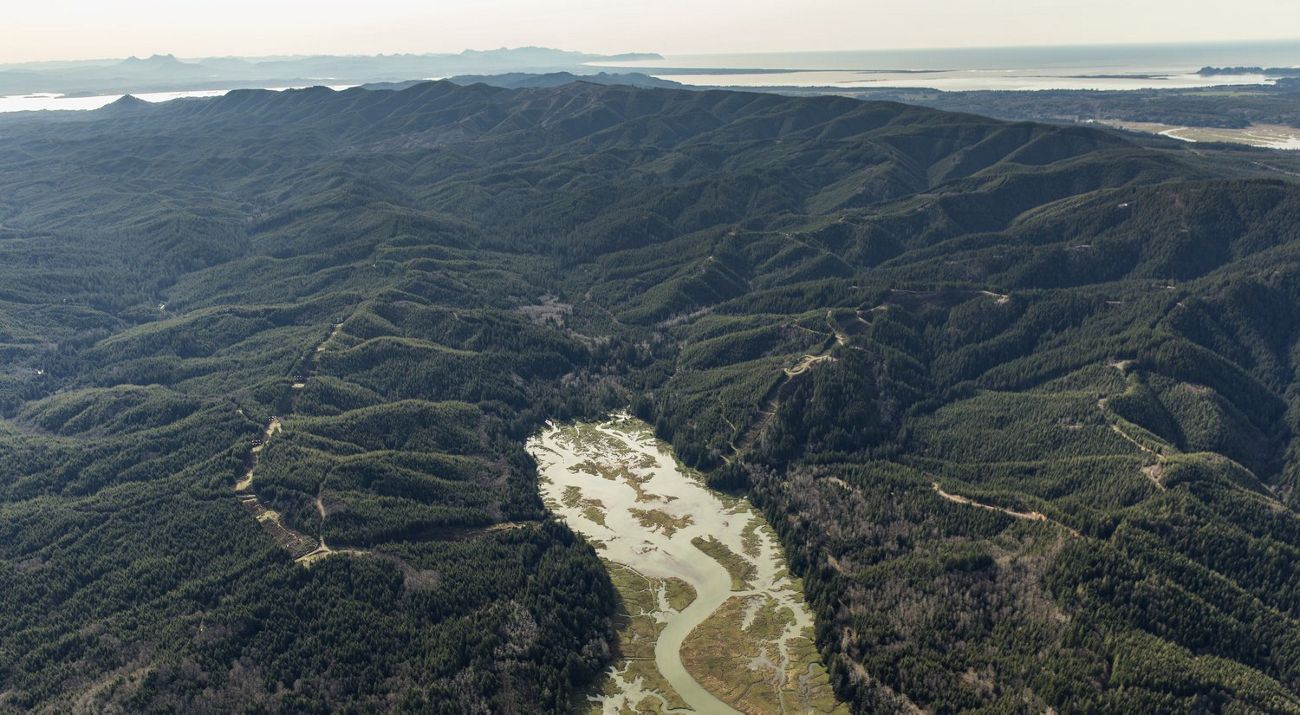Land management offers new strategies for Pacific salmon conservation
Study finds link between forest restoration and health of Willapa basin chum

Media Contacts
-
Tripp J Crouse
Media Relations Manager
Email: tripp.crouse@tnc.org
A recent study finds that land management efforts and forest restoration play an important role in ensuring the continuation of healthy salmon populations as oceans continue to heat up, providing critical insights into conservation strategies for the Pacific Northwest.
Published in Biological Conservation, the study evaluates chum salmon populations in the Willapa Basin in Washington state from 1984 to 2022, including how their dynamics varied with watershed-scale forest management, invasive species control efforts in Willapa Bay estuaries, and changing ocean conditions.
The research and study were supported by funding provided by The Nature Conservancy (TNC).
The study's most significant finding is that while ocean warming poses a substantial threat to salmon populations, land management and forest restoration can meaningfully buffer these negative impacts.
TNC Postdoctoral Scholar Michele Buonanduci holds a Ph.D. from the Quantitative Ecology and Resource Management program at University of Washington and is the lead researcher on the study.
"There's this perception that what's happening in the oceans is such a huge driver, and that what we do on land is just a drop in the bucket and can't really make a difference in terms of offsetting any of the negative effects of ocean warming,” Buonanduci said. “But our research shows that it can make a meaningful improvement in terms of salmon population health."
Chum salmon, the most abundant salmon species in the Willapa Basin, served as the primary focus of the research because of their importance to local ecosystems and the availability of long-term, consistent monitoring data in the Willapa basin.
The research explored how chum salmon responded to forest conditions in three southwest Washington locations, including TNC’s Ellsworth Creek preserve: a 7,600-acre preserve covering much of the Ellsworth Creek watershed that had been managed for timber production for much of the 20th century. Since the early 2000s, the preserve has been under TNC management, with a focus on restoring old-growth forest structure and improving wildlife habitat and watershed health.
TNC spent nearly 25 years conducting active forest restoration at the Ellsworth Creek Preserve, involving forest thinning, areas of road decommissioning, road management and stream restoration. These watershed-scale restoration efforts conducted through partnerships across public agencies and conservation organizations like The Nature Conservancy can offer critical help to Pacific salmon populations such as the Willapa basin chum.
Through Buonanduci et al.’s research, we are understanding how these restoration efforts benefit salmon populations compared with neighboring watersheds that continue to be intensively harvested for timber production. By integrating data across the salmon's entire life cycle, researchers also gained novel insights into population dynamics.
“There are actually not a lot of studies that look across the life cycle of salmon, integrating ocean life stages with freshwater life stages to ask, what are the effects of land management in the context of climate change?” said Ailene Ettinger, quantitative ecologist for TNC’s Washington chapter. Ettinger also is a co-author on the study.
“A lot of times, previous work has really focused on what the freshwater life cycle looks like but missed the portion of the life cycle that occurs in the ocean. Our study is unique in that we sought to understand how forest restoration supports salmon health throughout their entire lives, including what’s projected to happen in the ocean with climate change."
While the research focused specifically on chum salmon in Washington, it provides a model and approach that may be relevant for conservation efforts more broadly. The findings demonstrate that local conservation actions can have meaningful impacts, even in the face of significant climate challenges.
The research underscores three critical messages: the paramount importance of addressing climate change for salmon populations; the myriad benefits of ecological forest restoration; and the significant value of long-term ecological monitoring.
The study was made possible through collaborative research from scientists affiliated with TNC, University of Washington, Washington Department of Fish and Wildlife, U.S. Fish and Wildlife Service, and National Oceanographic and Atmospheric Administration, highlighting the value of long-term monitoring data collected by state and federal agencies. Co-authors of the study include Eric R. Buhle, Michael J. Case, Emily R. Howe, James C. Robertson, Nicholas VanBuskirk and Ailene K. Ettinger.
The Nature Conservancy is a global conservation organization dedicated to conserving the lands and waters on which all life depends. Guided by science, we create innovative, on-the-ground solutions to our world’s toughest challenges so that nature and people can thrive together. We are tackling climate change, conserving lands, waters and oceans at an unprecedented scale, providing food and water sustainably and helping make cities more resilient. The Nature Conservancy is working to make a lasting difference around the world in 83 countries and territories (39 by direct conservation impact and 44 through partners) through a collaborative approach that engages local communities, governments, the private sector, and other partners. For more news, visit our newsroom or follow The Nature Conservancy on LinkedIn.